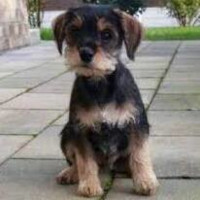Appearance of the Miniature Schnaupin
|
| Miniature Schnaupins have a cute, almost mischievous face. It often features large, pointed ears that are erect but tilt upwards, a black nose and round, dark eyes that sparkle with life and curiosity. Top it all off with a set of fluffy eyebrows and a pointed muzzle with whiskers and you've got this lively little dog. The body is light and athletic and can be smooth or wavy, as well as multicolored. The short, strong legs may be feathered, depending on the parental genetics they inherit. Puppies may vary in appearance within a litter, and even vary in size or the weight they reach. A medium-length tail is proudly held, and these engaging little dogs have a smile that will elicit a response from all who meet them. |
Temperament of the Miniature Schnaupin
|
| Miniature Schnaupins are known for their playfulness and sense of fun. They also like to know how things work, especially toys, which means you can go through a few toys as they take them apart to find out how they work. These little dogs are lively and get on well with children, making them ideal pets. They're companion dogs and will want to be part of the family, ideally the center of attention. The Miniature Schnaupin can sometimes be feisty and over-confident, but responds well to training if it's fun and they receive positive feedback. Training will overcome their tendency to want to do things their own way and curb their somewhat stubborn nature. Coming from a working environment, they are very active and may chase the neighbor's cat or small animals unless they are well socialized when they are young. Training them to curb their tendency to chase anything that moves can take time, so keep them on a leash when out and about. They're also very clever at discovering holes or places where they can scale a seemingly secure fence, so watch out for these little escape artists. They'll love a yard to explore, but can adapt wonderfully to apartment life as long as they take their daily walk or can run around the dog park for about half an hour every day. These dogs are affectionate, friendly and fun. There will never be a dull moment with a Miniature Schnaupin in the house. |
Needs and activities of the Miniature Schnaupin
|
| The Miniature Schnaupin is a small dog with a medium to high activity level. Although this can vary between dogs of the same breed, they are normally quite curious and will follow you around to see what you're doing and how they can help. A daily walk is important for their fitness and health, and will help socialize these small dogs with twice the attitude. The hunting instinct is still quite strong, so it's advisable to keep them on a leash as they may take off and practice “selective deafness” to your commands while chasing their prey. They'll be delighted to accompany you on a run or trek - life's an adventure, and they want to be part of it. Afterwards, they'll climb onto your lap and enjoy a good cuddle and a nap. |
Maintenance of the Miniature Schnaupin
|
| Miniature Schnaupins are relatively easy to care for, requiring only brushing perhaps once or twice a week to keep them in good health. They have minimal shedding, which makes maintenance very quick, although they'll love to sit and absorb your attention. Because the ears are quite large for their size, it's important to check inside them for foreign bodies like seeds or dirt that can get stuck and cause inflammation. Gentle cleaning will help keep them healthy. Other maintenance issues involve teeth care and hygiene, which is easy to do if the Miniature Schnaupin has learned to have his teeth cleaned. Bathing is only necessary if he's been in the mud or rolled in something unpleasant, but using a mild dog shampoo will maintain the coat's natural oils. Finish grooming by checking their nails and gently trimming them if necessary. |









 English (United Kingdom)
English (United Kingdom)